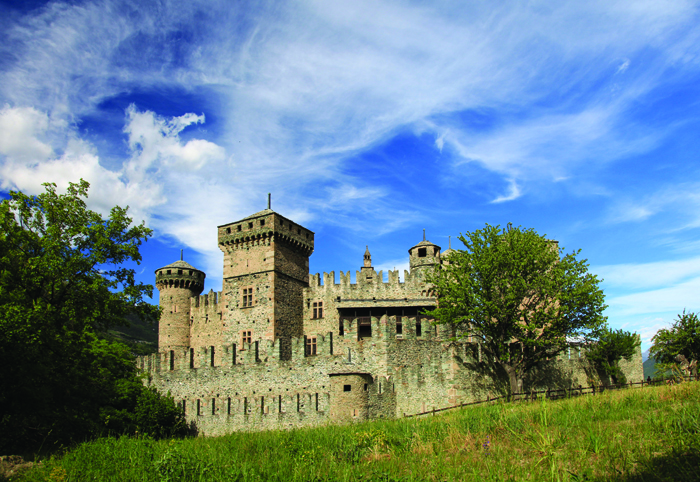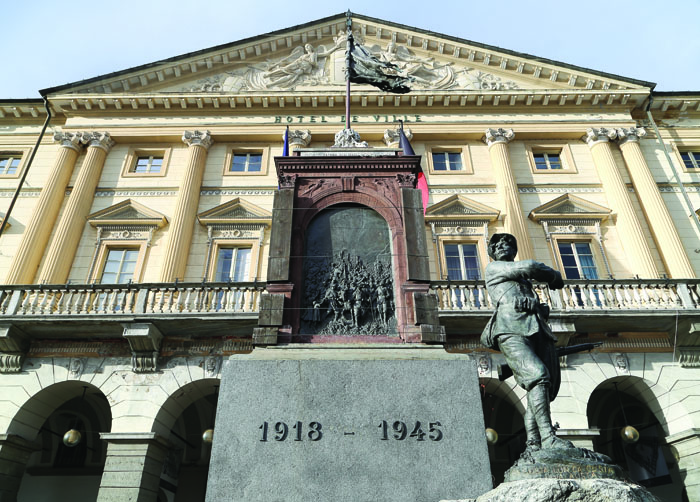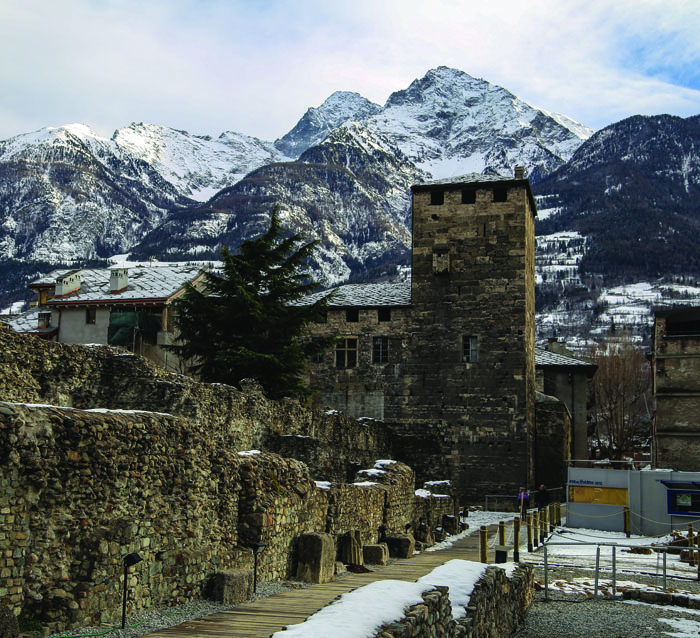Valle d’Aosta is now part of Italy, but it hasn’t always been. Chris Allsop travels to Italy’s smallest region and discovers a valley beloved of kings, popes, and – of course – skiers…
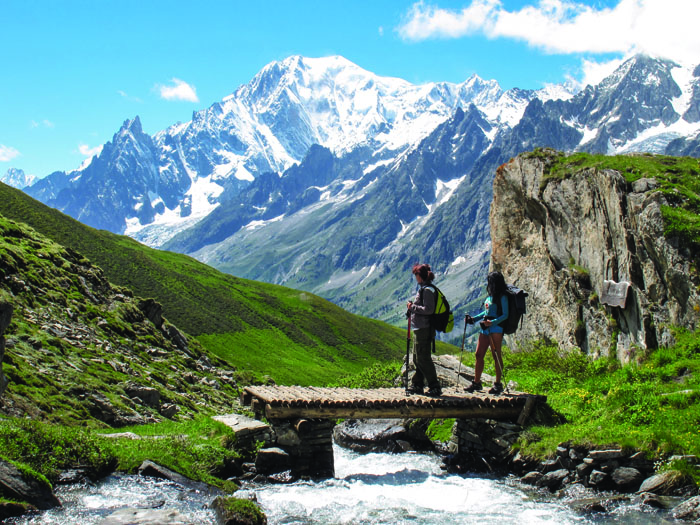
There’s something of the hidden kingdom about the Valle D’Aosta, like an Italian Bhutan (but with a lot more ski lifts). Entering from France via the seemingly endless Mont Blanc Tunnel, you’re transported from alpine foothills and farmland, in winter with horses stark black against frozen white pastures, and into an encirclement of soaring peaks. Arriving at sunset is particularly enchanting: as you switch back along the mountain roads your view alternates between the golden warmth of the sun-bathed west-facing ridges and the shadows deepening in the static pattern of the vertical snow-laden forests.
The Valle D’Aosta is exactly that: a valley; a beautiful glacial valley that sweeps east-west through the region (making it delightfully simple to navigate). The SS26 is the main highway, running the same valley floor route favoured by the Romans, fed by the Mont Blanc Tunnel and eventually tending south into neighbouring Piedmont. Hugging the western border is France, and the region has been bounced between the power centres of Burgundy and Savoy throughout its history. You can witness the legacy of this in the valley’s many spectacular castles, taste it in the French-influenced cuisine, and hear it in the local Franco-Provençal dialect (a language still used by 55 per cent of the population, and, most crucially, also among the youth).
My 48 hours immersed in Valdostan culture began at an altitude of 4,760 feet in the former mining town of La Thuile. We approached it in the pitch dark, finally emerging into the merry streetlights of thin village streets.
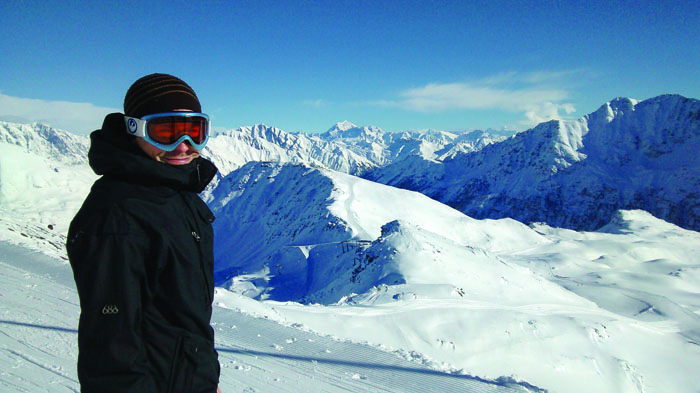
La Thuile is one of five villages facing Mont Blanc that form an historical unit called the Valdigne. In Savoy times, the quintet was under direct control of the royal family, and developed traditions unique to this administrative nook; newly elected mayors, for example, to this day find a pine tree pruned of lower branches and freshly planted before their houses as a way of celebrating their taking of office.
Nowadays, La Thuile is best known as ski resort and is commonly referred to as “Little Siberia” for its dependable conditions. It’s not the best known in the area (more high profile are Courmayeur, Cervinia and Monterosa). This is due, for the most part, to its sleepier après-ski scene, although another reason may be its relative scarcity of black runs (not an impediment to the Women’s World Cup Downhill, which is being held in February, 2016, on the truly alarming Piste No. 3 – the first World Cup race to be hosted at the resort).
But what it lacks in terrifying ice cliffs it more than makes up for in extensive, flowing blue and red runs. The views from the pistes are also incredible, with some of Europe’s most towering peaks – Mont Blanc, the Matterhorn, Monte Rosa, and Gran Paradiso – visible on a clear day. You can even ski into France – La Thuile teams up with its French neighbour La Rosière to form Espace San Bernardo, meaning that a single ski pass offers you 80 pistes, or 160km of slopes, to indulge in (snowboarders beware of the epically dreadful button lifts returning you from the French side to the Italian – you have been warned). Best of all, due to La Thuile’s lack of glitz, the pistes can feel uncrowded, even in high season. (Locals like to say that those staying at glamorous Courmayeur come across to enjoy the extra space at La Thuile before sneaking back in the evenings.)
However, that may all be changing. The Nira Montana, the resort’s first five-star hotel, opened at the end of 2014. A Design Hotels member, the hotel is beautifully presented with designer touches, rooms that smell like Darjeeling tea, and a fully equipped spa. The hotel has an up-market restaurant and a well-stocked bar, around which La Thuile’s après ski scene has reoriented.
Outside of the ski season, the alpine landscape, carpeted in shaggy firs and drifts of silver birch, offers much for the nature lover and adventure sports fans: around La Thuile alone, mountain bikers can enjoy 220 km of track, transporting their bikes up the slopes using the chair lifts. Valle D’Aosta’s national park, which it shares with Piedmont, is the Parco Nazionale Gran Paradiso – the first national park to be established in Italy. The trekking here is superb, with abundant wildlife, and the routes are serviced by cosy, traditional rifugios serving a surfeit of carb-heavy cuisine.
Snaking down the switchbacks from La Thuile to join up with the motorway tracing the valley floor takes three quarters of an hour, but it’s the winding mountain roads that adds the time – from the Mont Blanc Tunnel in the region’s northwest corner to the Piedmont border in the southeast only takes about an hour to drive. The River Dora widens out along the valley floor as you approach Aosta, and it’s not long before you start to see fortresses rearing up on both sides of the motorway. There are numerous castles scattered throughout the mountains, but of the ten most spectacular you can find Fénis Castle, Saint-Pierre Castle, Issogne Castle, the Bard Fortress (featuring in the forthcoming Avengers: Age of Ultron), Ussel Castle, Avise Castle, Sarre Royal Castle with its distinctive square tower, and Castello La Mothe all in view while driving the SS26.
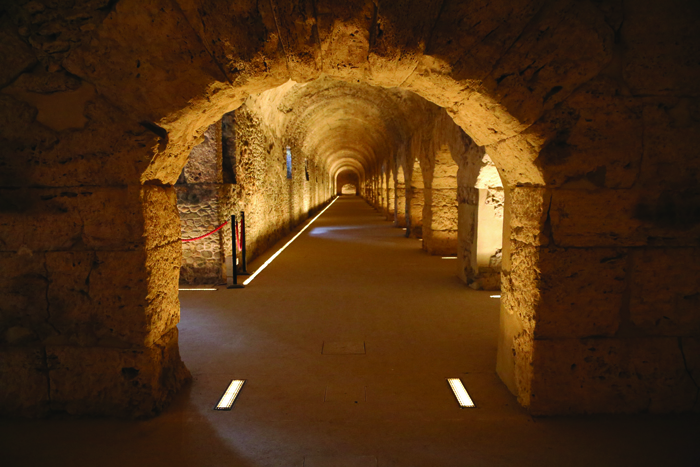
Besides royalty, popes have also favoured the Valle D’Aosta for a bit of R&R. Both John Paul II and, later, his successor, Benedict XVI, have holidayed in a chalet at the picturesque village of Les Combes. At the time of going to press, the valley grandees were still awaiting a response to their invitation for Pope Francis to follow in his predecessor’s footsteps.
Driving through the valley, you might notice grapevines scaling the valley walls. The Valle D’Aosta has some of Europe’s highest vineyards; the wine is produced in small amounts and, as such, is mostly consumed within the region. So stock up while you’re here: the bracing mountain air imbues the wines with a delicious freshness and they’re wonderfully aromatic. Look out for delicious indigenous grape varieties such as Fumin, which produces a tannic, peppery wine reminiscent of Syrah.
You’ll encounter small villages and towns all along the SS26 – these are cobbled into 70 municipalities beyond Aosta city limits. If at some point in conversation a local refers to living on the “right side of the valley”, they’re using a shorthand to refer to the side of the valley that receives the most sun – this sunny side is the “right side”, with correspondingly more expensive real estate. Inhabitants of the wrong side suffer from an absence of sun on their windowsills for a 20-day stint every winter.
Founded at the beginning of the Imperial Era, in 25BC, Aosta was part of a chain of towns linking through the Europe Crossway that breached the wall of the Alps. Named after the Emperor Augustus, the city that stands today is, by modern standards, small. The total population, including surrounding areas, is only about 60,000 – about a half of the region’s total. But with the Valle D’Aosta being semi-autonomous, and not coincidentally one of the richest provinces in Italy, this amounts to cobbled medieval streets lined with some serious shopping opportunities.
Upmarket ski tourists, shoulders bristling with furs, mingle with the locals in the pedestrianised area that takes in some of the prettiest parts of the city. Pop into La Vineria on Via St Anselmo (named after a somewhat neglected local saint), the town’s main commercial drag, for superbly knowledgeable staff who’ll point you to interesting (and cheaper) alternatives to the most famous local wine brand, Les Crêtes. And where there is wine, there is cheese: fontina is probably the most famous regional variety; made in the area since the 12th century, it’s hard to eat a meal without this semi-hard, cow’s milk treat featuring (usually melted). Find the Maison de la Fontine (aka ErbaVoglio) on Via Monseigneur de Sales for a pungently superb selection of Valdostan cheeses, including some made exclusively for the shop, like the grassy, mellow Renque Fleur.
But, however delicious melted fontina is, it’s the fantastic Roman ruins that will linger longest in your memory: the windows in the multi-storey remains of the theatre framing a looming peak, or the tiered stone seating bearing long white cushions of snow. Access to these are free, as is admission to the detailed and well-decked out Archaeology Museum (Piazza Roncas, 12) tracing the city’s history from pre-Roman times (also see francescocorni.com for artist’s impressions of how the archaeological sites used to look). Unfortunately, you won’t be able to visit the amphitheatre as the St Joseph nuns are now housed on top of it, but the tell-tale curve of the nunnery following the ancient design is an example of how this city, and region as a whole, has stepped so lightly into the grand shoes of its impressive history. Now hit the Via St Anselmo and shop till you drop.
